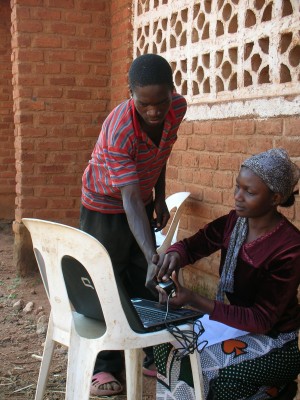How do we offer credit to unidentifiable people?
How do we offer credit to unidentifiable people?

How do you offer a loan to a farmer that can provide no evidence of his credit history or even of his true identity? Microfinance institutions (MFIs) in developing countries face this question every day, as they work to extend credit to people living in countries without credit bureaus, national identification systems, or sometimes even formal identification documents like birth certificates. Without a unique identification system, MFIs cannot track a client’s credit history, either within a single organization or across multiple lenders. When MFIs do not know who has a good credit history, there is no way to give creditworthy clients access to more and bigger loans, and no way to restrict clients with a history of defaulting.
In a
recent study of farmers in rural Malawi, IPA Researchers Dean Yang, Xavier Gine, and Jessica Goldberg looked at how loan repayment rates and access to credit were affected when an MFI collected fingerprint data on its clients so that it could identify them in the future. Farmers were divided into a group whose fingerprints were collected at the time of their loan application, and a comparison group, whose fingerprints were not collected. The results were striking: among the farmers who were fingerprinted, 85% of those considered to be high-risk fully repaid their loans, whereas only 44% of high-risk borrowers in the comparison group fully repaid the loan. The data shows that when high-risk borrowers know that the MFI can easily identify them in the future, they are more likely to take out smaller loans, and they are more likely to use the loan for the intended purpose. Furthermore, because of the increased repayment rates, every dollar that the MFI invested in fingerprinting technology resulted in an extra $2.34 of profit.
The
results of this study have implications for credit markets in Malawi and in other developing countries. They reveal the importance of being able to correctly identify borrowers in an efficient credit market, and may provide information on how borrowers’ behavior might change upon the introduction of a credit bureau.
 How do you offer a loan to a farmer that can provide no evidence of his credit history or even of his true identity? Microfinance institutions (MFIs) in developing countries face this question every day, as they work to extend credit to people living in countries without credit bureaus, national identification systems, or sometimes even formal identification documents like birth certificates. Without a unique identification system, MFIs cannot track a client’s credit history, either within a single organization or across multiple lenders. When MFIs do not know who has a good credit history, there is no way to give creditworthy clients access to more and bigger loans, and no way to restrict clients with a history of defaulting.
How do you offer a loan to a farmer that can provide no evidence of his credit history or even of his true identity? Microfinance institutions (MFIs) in developing countries face this question every day, as they work to extend credit to people living in countries without credit bureaus, national identification systems, or sometimes even formal identification documents like birth certificates. Without a unique identification system, MFIs cannot track a client’s credit history, either within a single organization or across multiple lenders. When MFIs do not know who has a good credit history, there is no way to give creditworthy clients access to more and bigger loans, and no way to restrict clients with a history of defaulting.











